Easier to measure emissions of greenhouse gases and ammonia from fields
Danish Technological Institute develops new methods to measure the climate and environmental impact of environmental technologies in plant production
In a new project (REM - Reduction of Emissions from Field), Danish Technological Institute investigates how new measuring methods make it easier and faster to measure the climate and environmental impact of environmental technologies in plant production.
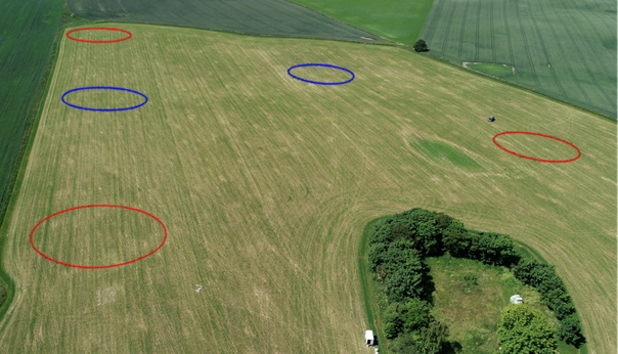
Picture 1. Analyze Station - Experimental field where treated and untreated slurry are placed in the blue and red circular plots on a grass field. Emissions are measured from the center of the plots and are thus independent of the wind direction due to the circular shape.
In the future, it will be easier and faster to measure the effect of new environmental technologies on greenhouse gases such as nitrous oxide and the evaporation of ammonia from the field.
- Today, it is expensive, troublesome and time-consuming to measure the greenhouse gas emissions of the highly climate-harmful nitrous oxide and ammonia from the agricultural soil. This is due to both manual measuring methods and the need for long-term measurement to obtain sufficient data with current measuring methods, says Senior Specialist Mathias Andersen, Danish Technological Institute.
Only a few institutions, primarily universities, can measure nitrous oxide and ammonia from the field, and there is a long wait to test whether new environmental technologies have the desired effect. In the future, the Danish Technological Institute can offer manufacturers of environmental technology verification of the reduction effect for both ammonia and nitrous oxide in yield tests. Through the project, Danish Institute will develop a new measurement concept where it is expected that the measurement period can be reduced from one year to a few months. The long-term goal is for the measurement concept to be recognized and can constitute a standard for how greenhouse gases and ammonia are measured from plant production.
- A new combination of measuring methods being developed in the project should enable the measurement of both nitrous oxide and ammonia emissions at the same time as yield tests. In this way, technology producers can save both time and resources on testing and verification of the technology's effect on both climate and the environment as well as economically through yield and quality measurements of the crop, says Mathias Andersen.
This is one of the objectives of the REM - Reduction of Emissions from Field project, which is supported by the Green Development and Demonstration Programme (GUDP) and started in the spring of 2020.
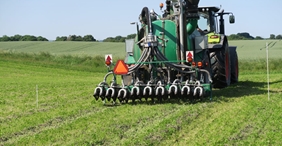
Picture 2. Laying slurry in 6 plots on a clover pasture after the second cut.
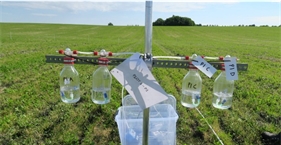
Picture 3. In each plot is placed a stand with 4 wash bottles containing dilute sulfuric acid to collect NH3.
At the same time, a measuring tube is connected to a multigas analyzer, where CO2, NH3, CH4 and N2O are measured in parallel and continuously
Three technologies into play
Agriculture accounts for more than 20% of total greenhouse gas emissions in Denmark and is therefore an area where great efforts are required if the goal of climate neutrality in 2050 is to be achieved. Similarly, agriculture accounts for about 97% of the total ammonia evaporation that is detrimental to the surrounding environment and is an indirect source of nitrous oxide emission. Therefore, technologies need to be brought into play more quickly, which can help reduce emissions from agriculture.
- One of the aims of the project is to document the effect of three technologies, all of which relate to slurry treatment from the companies JH Agro, N2 Applied and FCSI. Together, they can have a great impact on the overall emissions from barn and storage to field, and thus play a key role in achieving the reduction targets in Denmark and at the same time reaching beyond the country's borders, says Mathias Andersen.
Emission of nitrous oxide from plant production
About half of the greenhouse gas emissions from agriculture originate from plant production, and here nitrous oxide accounts for a large proportion of the emissions. Nitrous oxide is formed during the process of nitrification and denitrification and is released mainly in connection with fertilization and cultivation of the soil, where nitrogen is added to the soil. Nitrous oxide (N2O) affects the climate about 300 times as much as carbon dioxide (CO2). Ammonia (NH3) is not a direct greenhouse gas, but evaporation of ammonia from the fields impacts on the surrounding environment with nitrogen, some of which is also converted to nitrous oxide.
- At present, there is a great need to identify and uncover technologies that can help reduce greenhouse gas emissions and ammonia from agriculture, as today there is little knowledge of the effects of these technologies on climate and ammonia evaporation. To achieve this, work is being done on the development of new and optimized measuring methods, which will make it faster to investigate the potential of the technologies compared to ordinary practice, says Mathias Andersen.
The first practical test in the project has just been completed, where ammonia emissions from a clover grass field with untreated digested slurry and treated digested slurry have been measured (Figure 1). The measurements took place over a week in which traditional and manual measuring methods were tested in parallel with automated advanced measuring methods.
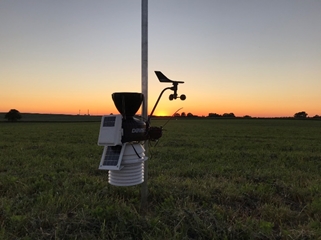
Picture 4. Weather station located on an experimental field where the wind speed at a certain height is used to calculate the emissions.
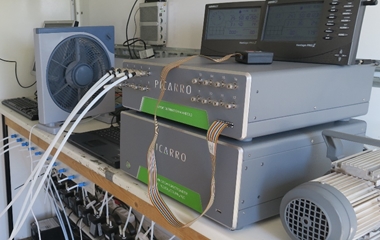
Picture 5. Measuring layout, where advanced measuring equipment is installed. The equipment can collection in impingers, which need to be replaced manually. The new measuring equipment uses the ”Cavity ring-down spectroscopy” measurement principle for continuous measurement of CO2, NH3, CH4 and N2O.
Time-consuming measurements
Automatic data collection in field trials
Today, it is standard to take manual samples and analyze them for nitrous oxide and ammonia via various measuring methods, but with the new method Danish Technological Institute expects that it will be possible to measure both nitrous oxide and ammonia simultaneously via online measuring equipment, which can measure very accurately in high temporal resolution. Likewise, data from several different treatments can be collected continuously in the same experiment. This will allow you to assess both the yield and quality of the crop treated with a given environmental technology and at the same time determine the climate and environmental impact of the technology in the field through the same test.
The Project Reduction of Emissions from Field, REM is supported by the Ministry of Environment and Food of Denmark’s green development program GUDP with just over DKK 4 million in support and runs until 2023.

- Projekt - Rem - reduktion af emissioner fra mark
- Ny teknik vil gøre det lettere at måle udledning af lattergas og ammoniak